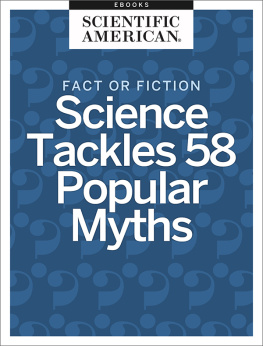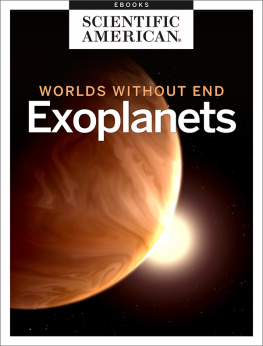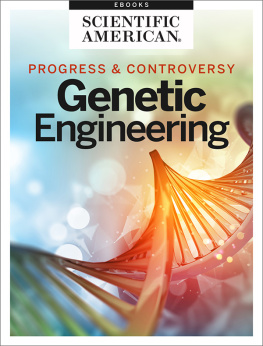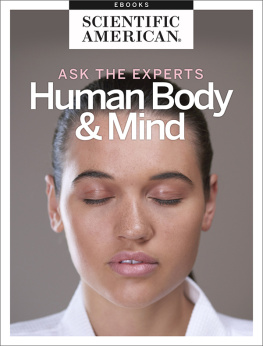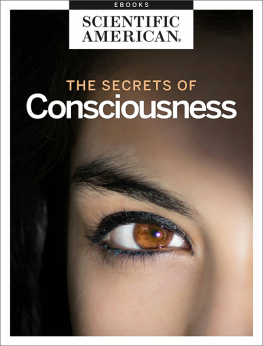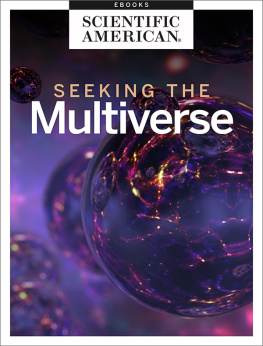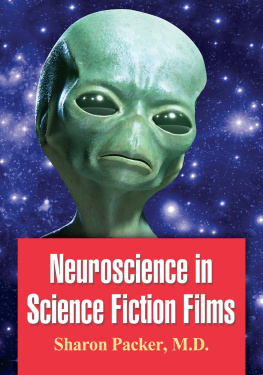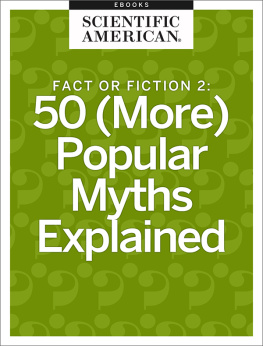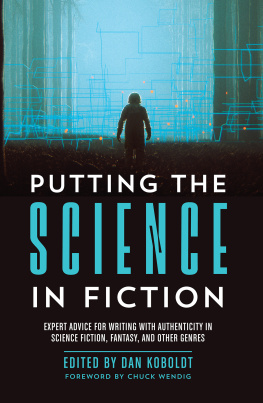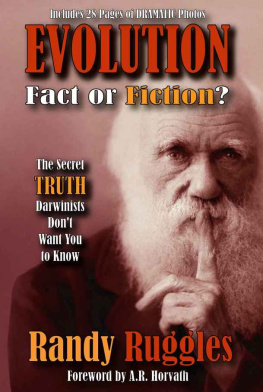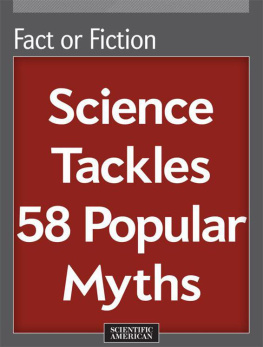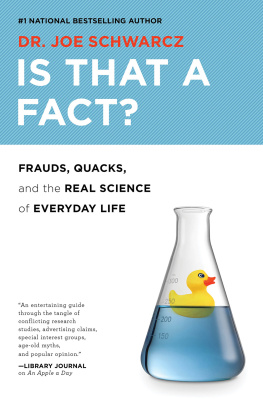Fact or Fiction
Science Tackles 58 Popular Myths
From the Editors of Scientific American
Letters to the Editor
Scientific American
One New York Plaza
Suite 4500
New York, NY 10004-1562
or editors@sciam.com
Copyright 2017 Scientific American, a division of Nature America, Inc.
Scientific American is a registered trademark of Nature America, Inc.
All rights reserved.
Published by Scientific American
www.scientificamerican.com
ISBN: 978-1-466842526


Fact or Fiction
Science Tackles 58 Popular Myths
From the Editors of Scientific American
Table of Contents
Introduction
by Hannah Schmidt
Section 1
1.1
by Alison Snyder
1.2
by Philip Yam
1.3
by Charles Q. Choi
1.4
by John Matson
1.5
by David Biello
1.6
by James Ritchie
1.7
by Cynthia Graber
1.8
by Robynne Boyd
1.9
by Melinda Wenner
1.10
by Anne Casselman
1.11
by Tina Adler
1.12
by Ferris Jabr
Section 2
2.1
by John Matson
2.2
by Katie Cottingham
2.3
by Katherine Harmon
2.4
by Nikhil Swaminathan
2.5
by Nikhil Swaminathan
2.6
by Anne Casselman
Section 3
3.1
by Meredith Knight
3.2
by Coco Ballantyne
3.3
by Robynne Boyd
3.4
by Charles Q. Choi
3.5
by John Matson
3.6
by Ciara Curtin
3.7
by Ciara Curtin
Section 4
4.1
by Ciara Curtin
4.2
by Larry Greenemeier
4.3
by John Matson
4.4
by Nikhil Swaminathan
4.5
by David Biello
Section 5
5.1
by Sushma Subramanian
5.2
by Cynthia Graber
5.3
by Karen Bellenir
5.4
by Coco Ballantyne
5.5
by Jonathan Scheff
5.6
by Coco Ballantyne
5.7
by Molly Webster
5.8
by S. M. Kramer
5.9
by Coco Ballantyne
Section 6
6.1
by Ciara Curtin
6.2
by Fran Hawthorne
6.3
by Barbara Juncosa
6.4
by S. M. Kramer
6.5
by Melinda Wenner
6.6
by Corey Binns
6.7
by Coco Ballantyne
6.8
by John Matson
6.9
by Karen Schrock
Section 7
7.1
by Charles Q. Choi
7.2
by Kayt Sukel
7.3
by Christie Nicholson
7.4
by Christopher Mims
7.5
by Christie Nicholson
7.6
by Robynne Boyd
Section 8
8.1
by David Biello
8.2
by JR Minkel
8.3
by John Matson
8.4
by John Matson
Stranger Than Fiction
Truth is stranger than Fiction, but it is because Fiction is obliged to stick to possibilities; Truth isnt. Mark Twain
The mythology of our everyday lives is often startlingly convincing. Folk knowledge, old wives tales and urban legends have the power of the populace behind themthe could-all-those-people-be-wrong effect. (Answer: yes, they can.) Then, some stories are so outlandish that their very incredibleness makes them seem crediblethe how-could-anyone-have-made-that-up effect. (Answer: with some imagination.) Whatever the reason, that human beings will suspend disbelief to admit the possibility of the strange and extraordinary is one of our best traits as a species. That we sometimes fail to check our source material, not so much.
Enter Scientific American s Fact or Fiction? and Strange But True columns. Like Mythbusters and snopes.com, these short, entertaining columns are dedicated to revealing the veracity and the mendacity in common lore. This eBook, Fact or Fiction: Science Tackles 58 Popular Myths , presents a sampling of the surprising, fascinating, useful and just plain wacky topics discussed by our writers over the years. We uncover the truth behind common myths from personal health (you can put down those vitamins and that extra glass of water) to zany animals (think zombie cockroaches) to a NASA pen only Bill Gates can afford.
Section One, The Animal Kingdom, examines the intricacies and amazing qualities of our fellow earthly inhabitants. Virgin births can happen outside of the Bible and squid have a superpower. Whale waste might not be as shiny as gold, but it is similarly valuable. And no, your dog should not eat your leftover Valentine chocolate.
In Babies and Parents, the writers advise as to whether or not you should buy The Complete Mozart for your yet-to-be baby and whether or not Dad can help out with the breast-feeding. The sections Health Habits, The Body and Mind and Brain explore just how much of our common conceptions surrounding our selves and well-being are based in fact orarent. You should not, for example, pee on jellyfish stings, as that will make the situation simultaneously more painful and more disgusting.
Its inhabitants are enthralling, but Earth and the universe have their own quirks, as shown in The Environment: Earth and Space. This section looks at whether toilets really do flush in the opposite direction south of the Equator and whether black holes sing (and do they take requests). Finally, in Miscellany we present some pieces perfect for upping your Trivial Pursuit knowledge.
Science is defined by Merriam-Webster as a system of knowledge covering general truths, and we at Scientific American are constantly trying to separate fact from fiction in all topics, be it quantum mechanics or chewing gum digestion. This eBook is only a fraction of our publications continuous search for truth. But we hope its an enjoyable fraction and encourages you to do some myth busting yourself.
-Hannah Schmidt
Book Editor
SECTION 1
The Animal Kingdom
Chocolate Is Poisonous to Dogs
by Alison Snyder
A small dog should be belly-up after eating a handful M&M's, at least according to conventional wisdom. But watching "Moose," a friend's five-pound Chihuahua, race around a living room after his sweet snack makes one wonder: Is chocolate truly poisonous to dogs?
Dogs and humans have similar tastes. Like us, they seek out sweets and have no problem indulging. But unlike humans, our canine companions experience dangerous effects from eating chocolateit can poison them and in some cases is lethal. The hazard, however, is probably overblown, says Tim Hackett, a veterinarian at Colorado State University. Chocolate's danger to dogs depends on its quantity and quality. Large dogs can usually handle a small amount of chocolate whereas the same helping could cause problems for Moose and his pint-size kin.
Chocolate is processed from the bitter seeds of the cacao tree, which contain a family of compounds known as methylxanthines. This class of substances includes caffeine and the related chemical theobromine. Both molecules bind to receptors on the surfaces of cells and block the natural compounds that normally attach there. Low doses of methylxanthines can lead to vomiting or diarrhea in dogs, and euphoria in humans. Chocolate contains a significant amount of theobromine and smaller amounts of caffeine. If a large quantity of theobromine or caffeine is ingested, some dogs will experience muscle tremors or even seizures. These chemical constituents of chocolate can cause a dog's heart to race up to twice its normal rate, and some dogs may run around as if "they drank a gallon of espresso," according to Hackett. Moose, it seems, was on a "theobromine high."

